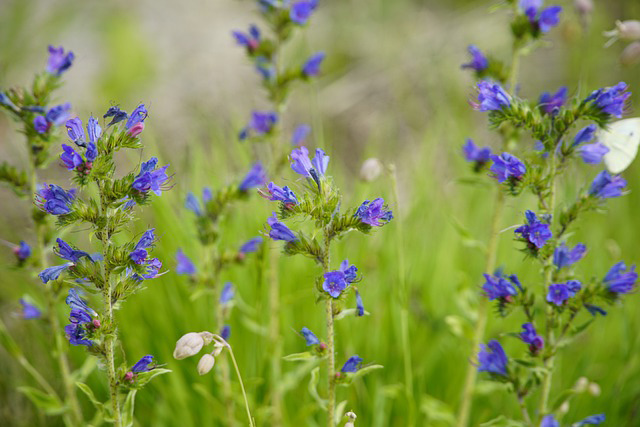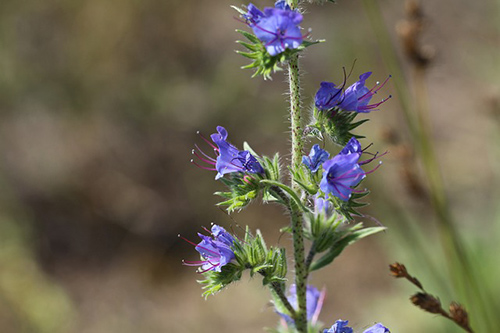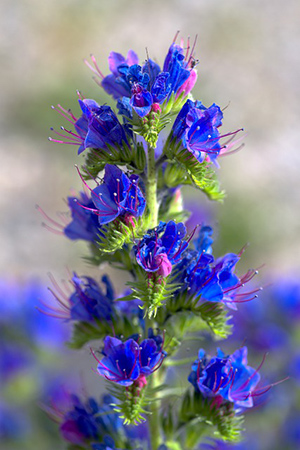Contents
The root of the bugloss plant contains a red coloring, the oldest coloring substance known. Its name Anchusa, derives from the Greek language, means “to paint” or “to dye.” Aelius Galenus recommended it for women’s makeup since it gives it a healthy red color when applied to the face. This application is no longer used.
Bugloss Plant Scientific Facts

- Other names: Large blue alkanet
- French: Buglosse
- Spanish: Buglosa
- Environment: Unfarmed lands of southern Europe, mainly with calcareous soils. It can also be found in wheat fields, vineyards, and olive groves. It is known in Central and South America.
- Description: Biennial plant of the Boraginaceae family, growing from 30 to 80 cm high. The stem and leaves are covered by rigid hair. The leaves have a shape and texture that have given this plant the name “ox tongue” in some languages. It has bluish flowers.
- Parts of the plant used medicinally: The flowers and leaves.
Healing Properties and Indications

The whole plant contains tannin, mucilage, choline, small amounts of allantoin (an alkaloid), and alkaloids. The flowers are used as sudorific and diuretic. They also have expectorant properties due to their content in mucilage.
Fresh juice from leaves and flowers is applied as an emollient (it reduces the inflammation of the skin and the mucosa) because of its content of mucilage and allantoin.
How to Use Bugloss
- Infusion of leaves and flowers, with 30g per liter of water.
- Compresses with the fresh juice of flowers and leaves, applied on the affected area.
Note: Common alkanet (Ancusa Officinalis L.) differs from the large blue alkanet by having purple flowers. Both species are used interchangeably since they have the same medicinal properties. Therefore, the common names are applied to either of these plants without distinction.
Bugloss plant Health Benefits

1. Anti-inflammatory Properties: Because the bugloss plant includes chemicals that can potentially decrease inflammation, It can help treat various diseases, including arthritis and other skin conditions that cause inflammation.
2. Wound Healing: Because of the plant’s antibacterial and antifungal characteristics, which can help prevent infection and assist the body’s healing process, it has been traditionally used to improve wound healing. This is because the plant contains these capabilities.
3. Antioxidant Effects: Antioxidants in the bugloss plant support the body’s ability to combat potentially damaging free radicals. There is a possibility that this might lessen the amount of oxidative stress that is now there, which would, in turn, reduce the probability of acquiring chronic illnesses such as cancer and heart disease.
4. Skin Health: Bugloss is utilized in skin care due to its emollient characteristics, which allow it to calm and hydrate the skin. Psoriasis, eczema, and dry skin are all affected by this, which makes it an excellent therapy for these conditions.
5. Respiratory Health: Traditional use of bugloss includes treating respiratory conditions, such as coughs and colds, possibly due to its anti-inflammatory and expectorant properties.
6. Digestive Aid: Bugloss has been used to improve digestion and treat gastrointestinal issues, including indigestion, constipation, and flatulence, possibly due to its anti-inflammatory and soothing effects on the digestive tract.
7. Liver Support: The plant may have hepatoprotective effects, supporting liver health and potentially protecting the liver from toxic substances.
8. Diuretic Properties: In addition to assisting in eliminating excess fluids from the body and enhancing renal function, bugloss has the potential to operate as a natural diuretic.
9. Immune System Boost: The nutritional and phytochemical content of bugloss, including antioxidants and vitamins, can contribute to strengthening the immune system.
10. Antimicrobial Activity: Some studies suggest that bugloss has antimicrobial properties, making it potentially effective against certain bacteria and fungi, which could be beneficial in preventing and treating infections.
DISCLAIMER: All content on this website is presented solely for educational and informational objectives. It would be best to not rely on the information provided as a replacement for advice, diagnosis, or treatment from a qualified medical expert. If you are pregnant, nursing, or have any preexisting medical concerns, you should talk to your doctor before using any herbal or natural medicines.
REFERENCES
- George D. Pamplona-Roger, M.D. “Encyclopedia of Medicinal Plants.” George D. Pamplona-Roger, M.D. Encyclopedia of Medicinal Plants. Ed. Francesc X. Gelabert. vols. 2 San Fernando de Henares: Editorial Safeliz, 2000. 696. Print. [Bugloss plant]
- Anti-inflammatory and Antioxidant Effects: The presence of bioactive compounds such as rosmarinic acid and flavonoids in many plants has been associated with anti-inflammatory and antioxidant properties. These compounds are common in the borage family and contribute to the health benefits of its members (Source: “Antioxidant and Anti-inflammatory Activities of Unexplored Brazilian Native Fruits,” PLoS One, 2016).
- Wound Healing and Skin Health: The application of plants with emollient and antibacterial properties in wound healing and skincare is well-documented in ethnobotanical studies. Compounds that promote tissue regeneration and prevent infection are valued in traditional medicine for these purposes (Source: “Traditional and Medicinal Uses of Carica papaya,” Journal of Medicinal Plants Studies, 2013).
